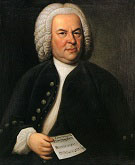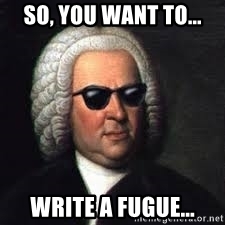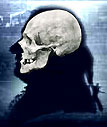

There are two kinds of music: The music of Johann Sebastian Bach and everything else. His music will forever be the first and final frontier[6]. It appears tremendously hard for anyone to transcend what Johann Sebastian has created in terms of music nor there seem to be any higher pleasure than actually listening to and/or playing his music.
Bach's music has a strange property: If you understand it, you automatically understand and can judge all other kinds of music, but the reverse is not true: You may not necessarily understand his music if you understand only a different kind of music. Therefore, one may claim with some certainty that "I understand music" is virtually synonymous to "I understand Bach's music".
The previous implies a sort of transcendent universality which only exists with his music. It is therefore not a coincidence that Bach has been called The Father of All Music and The Immortal God of Harmony.
It appears that Bach was the only human who has ever managed to connect directly to The Source of Everything, whatever this Source was or may be. This man's mind must have been immersed in harmony, 24 hours a day.
The author's love for Bach's music has led him closer to what he considers to be a deep investigation of the Christian faith. This has resulted primarily from the author's desire to interpret correctly Bach's music on the piano.
In the author's opinion, one cannot be a true Bach fan unless one has delved deeply into the internals of the Christian faith.
The author's favorite motto here is Matthew 7:16: "By their fruit, ye shall know them" and Matthew 11:29: "Take my yoke upon you and learn from me, for I am gentle and humble in heart, and you will find rest for your souls". Bach's music is rest for weary souls. Joyous soul refreshment. Are you tired? Weary? Disappointed? Feel bad? Feel like nobody cares? Somebody did: The entire musical output of Bach is aimed at helping you. Without fanfares, without boasting, without requiring credit, done in quiet and under severely adverse circumstances, aimed to calm and sooth the weary and tired soul. As such, Bach's fruit directly corresponds to the glorification of Jesus Christ (who in turn, according to Scripture glorified God), so his incredible music certainly conspires tremendously towards not only the validity of Christianity (in an ideal form and (perhaps?) detached from denominations) but also towards the kind of characters it shapes, when applied judiciously.
Bach has done so much work in the name of Christ that many people have espoused the Christian faith simply being in awe of his work. It is no accident he has been called "The 14-th disciple". This has a double meaning as with many things Bach: First, the number 14 was a sort of a signature for Bach himself, which he often used encoded in his music: given A = 1, B = 2, C = 3, etc., then B + A + C + H = 14. Second, if one considers him as a true disciple, he is indeed the 14-th one, after the apostles voted and elected a new disciple (the 13-th: Matthias) to replace Judas Iscariot (one of the 12): Acts 1:26: "Then they cast lots, and the lot fell to Matthias; so he was added to the eleven apostles.".
The last five works are in the author's opinion the epitome and apotheosis of all human creation. If this author was in charge of the Arecibo Observatory, he (agreeing with biologist Lewis Thomas) would instruct the astronomers of the observatory to transmit all of Bach's works continuously, in a cycle, into all directions in outer space, 24 hours a day, 365 days a year, every year, as long as humanity is alive. Such an act is a virtual guarantee that whoever's out there, will finally recognize us as somewhat civilized and might spare us when hard times come by.
There were monumental fights in the corresponding Bach newsgroup relating to whether Bach should be played on a piano or on a harpsichord. In the author's opinion, the piano allows for greater depth, perhaps such as the depth that the composer himself intended but was unable to witness, until the development of the later pianos. When the author was a teenager in 1982, the author's father told him about Glenn Gould. After listening to Gould for many years, in the author's opinion, Gould essentially proved that Bach can be extraordinarily played on the piano and settled the issue of interpreting Bach's music on any keyboard instrument. His recordings of concertos BWV 1052-1056, 1058 and his 1981 recording of the Goldberg variations practically put a lid on the issue of playing Bach on the piano, with most modern pianists who have Bach recordings always being compared to him. The listener will immediately recognize Gould's genius when he listens for example to his perfect rendition of Bach's Fugue 23 in B major BWV 892, from book II of the Well-Tempered Clavier, . However, the author disagrees with several of his interpretations. Here's the author's opinion[5] on his Well-Tempered Clavier Book I and Book II. Note that although this author disagrees with some of Gould's interpretations on the piano as per the above examples of WTC I and WTC II, the author's opinion on Gould remains unaltered as far as Gould being the absolute and final authority on Bach's interpretation on the piano. This opinion is of course not an accident and has been supported universally, since one of Gould's recordings is one of the entries in the Voyager Record.
The author's favorite performances of Bach's music on harpsichord are by Isolde Ahlgrimm, who used an Ammer pedal instrument with two claviers. These are on LP's bought by the author's father. The author is not aware if Philips has re-issued her recordings on CDs. If you find any of her Bach recordings online, buy them without hesitation!
Isolde, an Austrian harpsichordist, has been labeled "widow Bach" by many German and Austrian newspapers, before her death in 1992. Whenever she gave public performances, the crowd went absolutely nuts.
Her performances have been termed "historic", both concerning style and concerning value. Some actual favorites are:
The author's favorite performances of Bach's music on the Lute-Harpsichord are by Gergely Sárközy, who uses an instrument of his own making.
Hungarian Gergely Sárközy is a master of several instruments and an amateur instrument maker. His main instruments are harpsichord, organ, cello, viola da gamba, rebec, various types of lute, koboz, classical and flamenco guitar, psaltery, bagpipe, gemshorn, Jew's harp, xylophone and other percussion instruments. The following recordings are from his Hungaroton HCD 12461-2 Lute-harpsichord CD recording:
The author's favorite performances of Bach's music on guitar are by Dakko Petrinjak, John Williams, David Russel, Gergely Sárközy and the Los Angeles Guitar Quartet.
Lately, the machine aided by judicious editing and musical talent has proved to be superior to even Gould. John Lewis Grant using Giga-Studio has rendered Bach's Well-Tempered Clavier in a way which the author finds totally fascinating.
Here is the author performing[1]:
The Bachian fugue is the apotheosis of communication. It communicates perfectly to the listener the existence of perfect order, therefore it is virtual proof that The Supreme Creator exists and has allowed the composer of the Bachian fugue to be a vehicle for His message. Hence, composers who desire to write fugues in the style of Bach have an additional responsibility towards the listener. In the words of Bach himself: "The aim and final end of all music should be none other than the glory of God and the refreshment of the soul.".
To create a good Bachian fugue, a composer has to master ideal interval relationships between notes, which is something that depends heavily upon mastering ideal numerical ratios, in addition to mastering correct musical aesthetics. Many modern composers have a fundamental lack of these.
There is no guarantee that intensive studies in musical theory or harmony will make one a good Bachian fugue composer. Fugue Composition and Counterpoint are usually the last university courses prospective student-composers have to take after they master the fundamentals of harmony. Creating a good Bachian fugue is probably the most demanding and difficult task in this world. Accordingly, witness such fugues by the great composers, such as Beethoven, Mozart, Brahms, Vivaldi, Scarlatti, etc.[4].

Some compositions in the style of Bach by the author[2][3]:
 .
. .
. .
.
Some compositions not in the style of Bach by the author:
| Form: | Structure: | Symmetry: |
| Template (T's and t's) | C|-G-A-G| | Partial mirror A |
| Theme part #1: T1 | |C|-G-A-G|-C| | Extended template #1: Mirror A, palindrome |
| Theme part #2: T2 | C|-G|-A-G|-A| | Extended template #2: Partial mirrors A, G |
| Source Unknown | Aria |X-Y-X| | Mirror Y, with T1∈X and T2∈Y |
| Passacaglia I, II | Passacaglia |Z|-|Z|-...-|Z|,with 6 voices and |Z|=|X-Y-X| | Compound mirrors |Z|, with voiceσ(n)=|T1-T2-T1|∈Z, σ∈S6=Sym(M) and M={1,2,...,6} |
| Sub-theme:t | C|-G-A-G|-F-G | Extended template #3: Partial mirror A |
| Main theme: T | t-A-F-G-E-F-D-E | Sub-theme extended: Combinations -X-Y-Z from last notes of T2 ∪ t={A,F,G} |
| Modified sub-theme: t* | t|-A-G-F|-A-G-F|-E-G | Sub-theme extended: Combinatons -X-Y-Z from last notes of T2 ∪ t={A,F,G} repeated |
| Modified theme: T* | t*-F-E-D-F-E | Modified sub-theme extended |
| Counter-subject#1: cs1 | A-F-G-E-F-D-E | Last 7 notes of T: Combinations -X-Y-Z from last notes of T2 ∪ t={A,F,G}: Contra on t |
| Counter-subject#2: cs2 | B-A-B-C-B[7] | Contra on T (second entry) |
| Counter-subject#3: cs3 | |A-G-F|-A-G-F|-E-G-F-E-D-F-E | Combinatons -X-Y-Z from last notes of T2 ∪ t={A,F,G}: Contra on cs1 |
| Counter-subject#4: cs4 | C-C-B-A[7] | Second Contra on cs1 |
| "Joke" Fugue opus 7 | Double Fugue, with 4 voices | 4-voice fugue on T and T* with Contras csi in 3 episodes |
| "Joke" Fugue opus 7.1 (revision #1) | Double Fugue, with 4 voices | 4-voice fugue on T and T* with Contras csi in 5 episodes |
Some favorite compositions in the style of Bach by other composers (some stored on Sound Cloud. Couldn't find links to the original Church Organ .mp3's, sent to the author time ago in private communication):
Here's Bach's skull, superimposed on the famous Kanth sketch which appears on some of Isolde Ahlgrimm's recordings on LPs. Isolde Ahlgrimm had submitted a similar photo at the time of those recordings, which is contained in her WTC II album, and from the notes contained therein, the author quotes: "We submitted this photo to prof. J. Weninger, Head of the Institute of Anthropology at the Vienna University, who issued the following expert opinion: 'It must be admitted that in this case, the contours of the skull fit so well into the silhouette of the head that a respective relation is absolutely conceivable'."

There are naturally tons of noteworthy music - old & new. Follows a small preferred sample list (by no means exhaustive) - approximately starting with modern times and sorted backward of some music this author considers worthy when he decides to listen to something different from Bach for a change - unfortunately too long to be analyzed individually, so just pointing at a general YouTube reference for the reader's convenience in finding out more about it: